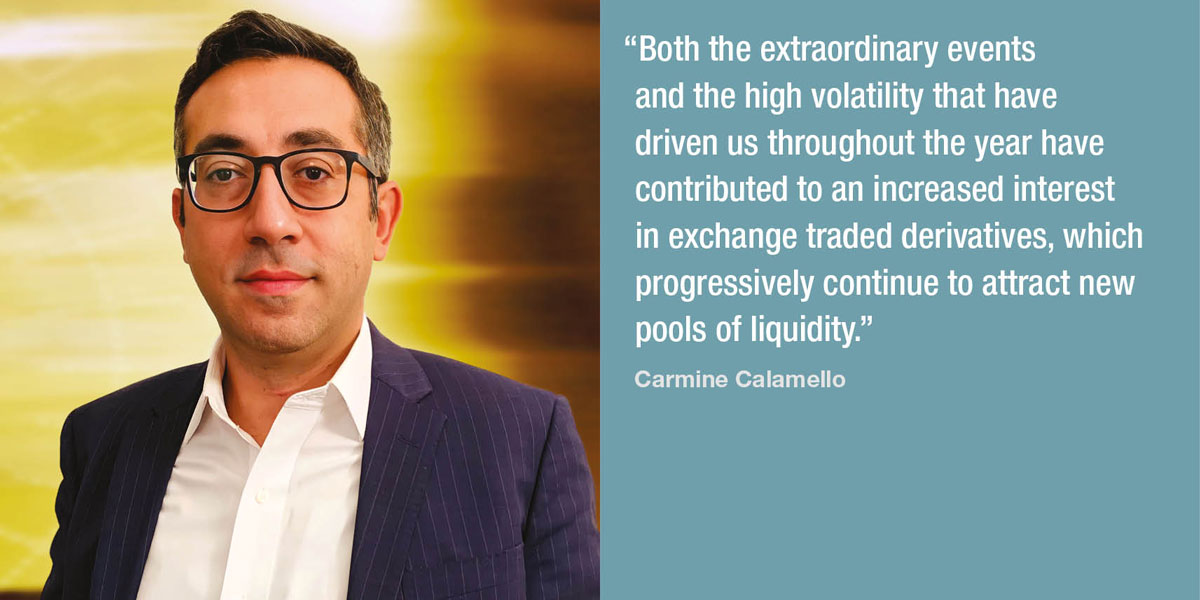Carmine Calamello, Head of Brokerage Desk, Market Hub – Intesa Sanpaolo Group
Some argue that the origin of derivatives contracts can be traced back to the Greek philosopher Thales. In a famous anecdote reported in Aristotle’s “Politics”, the philosopher, accused of practicing a discipline that had no concrete implications, had decided to prove that he could easily get rich by the sole use of his intellect. Having foreseen an abundant olive harvest, Thales raised a small sum of money with which he rented all the oil mills in Miletus for cheap. His small investment would turn into a large profit if his predictions came true, during which he would be able to fix the rent of the oil mills as a monopoly. The story, which in fact represents the purchase of a call option, demonstrates the importance that derivatives markets have always had for trading or hedging. The same logic is centric even today. Due to the effects of the pandemic, as well as those of the Russian invasion of Ukrainian territories, we now face the highest inflation since the 1970s and a strong increase in interest rates by central banks. Due to extreme market volatility and especially higher commodity prices, we observed investors hedging heavily and traders taking advantage of these price movements.
Volatility in turn impacts exchange traded derivatives volumes. Our trend analysis was confirmed by FIA’s Q3 report on global exchange traded derivatives (ETD) activity, which showed 61 billion contracts had been traded in the first three quarters, up 35.6% from 2021. In particular, commodities prices have been skyrocketing since January amid market and geopolitical turmoil, posing serious issues on the stability of exchanges, CCPs and market participants. The performance of futures contracts related to TTF Gas stands out, with the European Energy Exchange (EEX), growing 68% in YoY volumes, mostly concentrated on natural gas. Despite unseen spikes in prices that stabilised at levels five to ten times higher than before the turmoil for the gas and energy sectors, markets and clients proved to be resilient. In Italy, we observed no major players’ requests for government aid, although we witnessed extended liquidity support from the banks. Nevertheless, monetary tightening, economic slowdown, a strong US dollar and warmer-than-usual temperatures are already softening the pressure on energy prices, except for natural gas, for which we still see scarcity in European physical markets.
Margin calls peaked in Q1 2022, in the aftermath of the invasion, due to halted markets. Clients have been focussing much more attention in cash management and the margin implications of each open position. There has been a substantial rise in clearing limit breaches, mainly due to increased initial margin requirements rather than to increased derivatives open positions. This triggered many internal processes to reassess client limits. Volatility pushed CCPs to request more default funds contributions, especially on commodity markets.
Treasury departments were under pressure to manage margin calls and in some cases the swap from listed derivatives to bilateral OTC activity has been seen as a way to explore other sources of credit facilities. As a consequence of that, as liquidity drains in the market, OTC-cleared products grew substantially.
The Covid pandemic and the Russian invasion of Ukraine have resulted on one hand in increased traded volumes in derivatives markets, but on the other hand greater trade processing challenges (e.g. delays in give-ups, allocations, and average pricing), significant increases in initial margin requirements and in the number of margin calls. This situation led to the request for potential intervention by regulators and policy makers (e.g. for circuit breakers, price limits, and extension of acceptable collaterals). According to FIA cleared derivatives volumes reports, markets recorded a 30% reduction in volumes on Russian trading venues – due to war-related sanctions – that have been distributed on other European exchanges. For instance, from our privileged position in the market we observed Italy’s IDEM derivatives market volumes growing by 20% year-to-date compared to last year, as more investors turned to the exchange to hedge risks.
Markets were not caught off guard however, and this time showed resilience with respect to what happened in 2020, in the aftermath of the pandemic crisis. The Covid experience represented an accelerator of process innovation that started years before. Sell-side firms focused heavily on internal workflows and efficiency, and 2020 pressures on back-office activities were crucial in learning on how to react appropriately after the more recent war-related events. This is not enough however, and market participants are asking for more efficiency in trading and clearing services by exchanges and CCPs.
On the equities side, the common theme has been the attractiveness of equity index products that witnessed a global increase in traded volumes compared to 2021. On the contrary, the interest on single names faded on average, with some exceptions we observed on Italian banking sector single names derivatives trading activity.
Double-digit inflation and the consequent interest rates hikes have led to an increased activity on fixed income securities and in turn on their derivative products. The larger effects are seen on the short-end of the curve, with contracts on the 2 and 5 year US Treasuries experiencing the heaviest trading activity. In Europe, we witnessed the same paradigm, further exacerbated by regional political events such as the pressure on Gilts following former UK Prime Minister, Truss’s controversial proposed tax policies, and the Italian elections. In the US, SOFR products boomed as the Alternative Reference Rates Committee (ARRC) is transitioning from the USD LIBOR to more robust benchmark rates.
 Major interest was also seen on FX products, with futures on major currency pairs trading in the wake of multiple monetary policy choices. This was for example the case for JPY/USD, GBP/USD and EUR/USD that have seen volume increases of up to +40% YoY. Cryptocurrencies showed increasing volumes as well. In particular, the activity on Bitcoin and Ether grew 140% and 27% respectively compared to 2021. The market is watching closely the recent collapse of FTX and whether this event will be a turning point for the industry.
Major interest was also seen on FX products, with futures on major currency pairs trading in the wake of multiple monetary policy choices. This was for example the case for JPY/USD, GBP/USD and EUR/USD that have seen volume increases of up to +40% YoY. Cryptocurrencies showed increasing volumes as well. In particular, the activity on Bitcoin and Ether grew 140% and 27% respectively compared to 2021. The market is watching closely the recent collapse of FTX and whether this event will be a turning point for the industry.
Following the extension of the equivalence for UK CCPs until June 2025, due to potential financial stability risks, the European Commission is studying new measures to increase clearing activity on European CCPs and is expected to publish legislative proposals at the end of this year. The FIA opposes any regulatory mandate which would result in a competitive disadvantage for EU Clearing members and market participants, and advocates for voluntary market-driven solutions to develop competitive and resilient market infrastructures in the EU. This issue is even more complex in the commodity space where at present there is no serious alternative solution in Europe to gain a competitive advantage compared to the UK and US.
In conclusion, we can say that both the extraordinary events and the high volatility that have driven us throughout the year have contributed to an increased interest in exchange traded derivatives, which progressively continue to attract new pools of liquidity. The market is constantly evolving and will certainly offer new challenges in 2023.
Data for this article was sourced from FIA market data.
The author would like to thank Ivan Brambilla and Lorenzo Bracchi for their collaboration in writing this article.
©Markets Media Europe 2025












